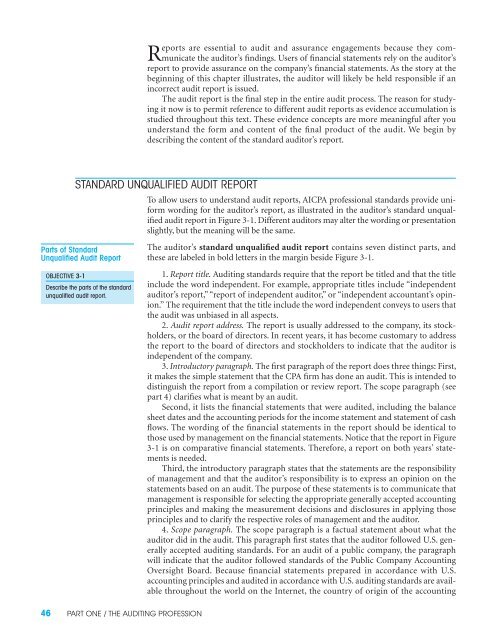audit reports
audit reports
audit reports
You also want an ePaper? Increase the reach of your titles
YUMPU automatically turns print PDFs into web optimized ePapers that Google loves.
Reports are essential to <strong>audit</strong> and assurance engagements because they com -<br />
municate the <strong>audit</strong>or’s findings. Users of financial statements rely on the <strong>audit</strong>or’s<br />
report to provide assurance on the company’s financial statements. As the story at the<br />
beginning of this chapter illustrates, the <strong>audit</strong>or will likely be held responsible if an<br />
incorrect <strong>audit</strong> report is issued.<br />
The <strong>audit</strong> report is the final step in the entire <strong>audit</strong> process. The reason for studying<br />
it now is to permit reference to different <strong>audit</strong> <strong>reports</strong> as evidence accumulation is<br />
studied throughout this text. These evidence concepts are more meaningful after you<br />
understand the form and content of the final product of the <strong>audit</strong>. We begin by<br />
describing the content of the standard <strong>audit</strong>or’s report.<br />
STANDARD UNQUALIFIED AUDIT REPORT<br />
To allow users to understand <strong>audit</strong> <strong>reports</strong>, AICPA professional standards provide uniform<br />
word ing for the <strong>audit</strong>or’s report, as illustrated in the <strong>audit</strong>or’s standard unqualified<br />
<strong>audit</strong> report in Figure 3-1. Different <strong>audit</strong>ors may alter the wording or presentation<br />
slightly, but the meaning will be the same.<br />
Parts of Standard<br />
Unqualified Audit Report<br />
OBJECTIVE 3-1<br />
Describe the parts of the standard<br />
unqualified <strong>audit</strong> report.<br />
The <strong>audit</strong>or’s standard unqualified <strong>audit</strong> report contains seven distinct parts, and<br />
these are labeled in bold letters in the margin beside Figure 3-1.<br />
1. Report title. Auditing standards require that the report be titled and that the title<br />
include the word independent. For example, appropriate titles include “independent<br />
<strong>audit</strong>or’s report,” “report of independent <strong>audit</strong>or,” or “independent accountant’s opinion.”<br />
The requirement that the title include the word inde pendent conveys to users that<br />
the <strong>audit</strong> was unbiased in all aspects.<br />
2. Audit report address. The report is usually addressed to the company, its stockholders,<br />
or the board of directors. In recent years, it has become customary to address<br />
the report to the board of directors and stockholders to indicate that the <strong>audit</strong>or is<br />
independent of the company.<br />
3. Introductory paragraph. The first paragraph of the report does three things: First,<br />
it makes the simple statement that the CPA firm has done an <strong>audit</strong>. This is intended to<br />
distinguish the report from a compilation or review report. The scope paragraph (see<br />
part 4) clarifies what is meant by an <strong>audit</strong>.<br />
Second, it lists the financial statements that were <strong>audit</strong>ed, including the balance<br />
sheet dates and the accounting periods for the income statement and statement of cash<br />
flows. The wording of the financial statements in the report should be identi cal to<br />
those used by management on the financial statements. Notice that the report in Figure<br />
3-1 is on comparative financial statements. Therefore, a report on both years’ state -<br />
ments is needed.<br />
Third, the introductory paragraph states that the statements are the respon sibility<br />
of management and that the <strong>audit</strong>or’s responsibility is to express an opinion on the<br />
statements based on an <strong>audit</strong>. The purpose of these statements is to communicate that<br />
management is responsible for selecting the appro priate gener ally accepted accounting<br />
principles and making the measurement decisions and disclosures in applying those<br />
principles and to clarify the respective roles of management and the <strong>audit</strong>or.<br />
4. Scope paragraph. The scope paragraph is a factual statement about what the<br />
<strong>audit</strong>or did in the <strong>audit</strong>. This paragraph first states that the <strong>audit</strong>or followed U.S. generally<br />
accepted <strong>audit</strong>ing standards. For an <strong>audit</strong> of a public company, the para graph<br />
will indicate that the <strong>audit</strong>or followed standards of the Public Company Accounting<br />
Oversight Board. Because financial statements prepared in accordance with U.S.<br />
accounting principles and <strong>audit</strong>ed in accordance with U.S. <strong>audit</strong>ing standards are available<br />
throughout the world on the Internet, the country of origin of the accounting<br />
46 PART ONE / THE AUDITING PROFESSION
















